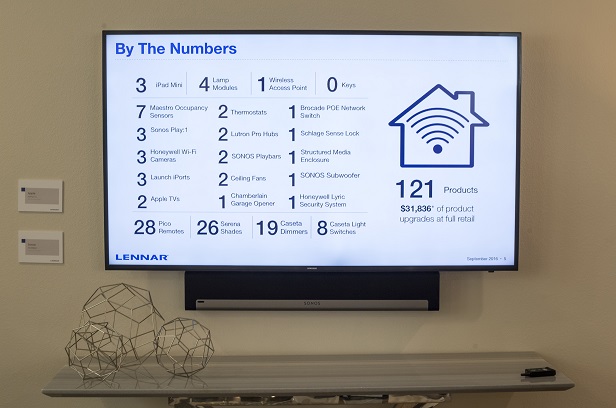
A homeowner rolls out of bed in the morning, and the kitchen light and coffeemaker have turnedthemselves on already. The heat has been driving out theovernight chill for ten minutes. She uses the last drop of milk,and the refrigerator updates her grocery list.
|As she drives away, she forgets to close the garage. But not toworry — it closes automatically.
|The security system arms itself when she's a quarter mile awayfrom home. Sensors watch for leaks and other potentialmishaps. Later in the day, the house prepares for her return:lights, heat, and any devices that are part of the eveningroutine.
|What's remarkable is how little effort it took to turn the houseinto an attentive virtual butler. It's recorded her routines forweeks or months, learning to anticipate her every need. This isartificial intelligence (AI), domesticated.
|Related: Top 10 smart home technologies for homeowners over50
|Insurance game-changer
On a less routine day, AI becomes a potential life- andcost-saver. When a smoke alarm sounds at 2 a.m., lights turn on,doors unlock, and detailed information goes to emergencydispatchers. The homeowner gains precious time to escape, and firstresponders get critical information, potentially making theirrescue and firefighting efforts more effective and the damage lesssevere.
|None of this is science fiction. But this experience for thehomeowner is just the start. As smart homes become self-taught,that same knowledge can stock a warehouse of data for thehomeowner's insurer, supporting tailored underwriting and pricing,more accurate underwriting, faster claims response, and moreeffective customer engagement to reduce risk.
|Related: 6 ways your smart home will cutcosts
|IoT's expanding reach
Consumers are embracing smart home technology, most vividlyshown by the explosive popularity of virtual assistants such asAmazon Alexa, Apple Siri, Google Assistant, Microsoft Cortana, andSamsung Bixby. VoiceLabs estimated that 24.5 million devices wouldbe shipped in 2017, up from 6.5 million in 2016.
|Less visible, but at least as telling, is the growth of the homesecurity market, a key intersection between the Internet of Things(IoT) and the interests of insurers.
|About a quarter of U.S. broadband homes are now equipped withmonitored security, according to Parks Associates. The homesecurity industry has been aggressively upselling new and existingcustomers to interactive systems that combine professionalmonitoring and home automation. Consumers have responded favorably,encouraging providers such as ADT, Alarm.com, and Vivint to keeppursuing this model.
|Cable and Internet providers have also moved strongly into thismarket. Comcast's Xfinity Home now exceeds 1 million households,making it a growth leader for the company as the cable industrybattles the “cord-cutting” trend. Meanwhile, traditional systemintegrators such as Lutron and Savant, which sell customized,full-home systems to high-end customers, are movingdown-market.
|Consumer trepidation
But as eagerly as customers have begun to embrace smart hometechnology, it's a harder sell to get them to unlock the databeing generated. And that creates a barrier for insurersseeking to realize the promise of the connected home. Privacy andsecurity concerns loom large, with consumers fearing theirinformation will be hacked or the feed from their security cameraswill fall into the wrong hands.
|Overcoming those fears may in part be only a matter of time andfamiliarity. Early misgivings about online banking and e-commerceeventually settled to a level where, although risk remains, mostconsumers can tolerate it.

But while the privacy question may be a temporary hurdle, it'stoo important to leave to chance. Until consumers are won over inlarge enough numbers, smart home data won't reach the critical massnecessary to produce reliable actuarial insights for individualinsurers. Analysts estimate that current North American smart homepenetration may grow to 28 percent by 2020, but currently onlyabout 5 percent of homes have a smart home device.
|Related: 7 ways auto technology is impacting insurancecoverage
|A fragmented market
Large and small players, from established cable providers andhome security companies to the crowded field of start-up smart homebusinesses, are looking to stand out with unique ways for customersto make the most of connected home technology. Among the partners these companies seek areforward-thinking insurers — those that see the potential forthe rising torrent of smart home data to sharpen underwriting andupgrade the customer experience in new ways.
|It's more than just serving up data and letting insurers siftthrough it for incidentally useful bits. Connected home companies are intensely interestedin what insurers want to know, so they can build value forinsurers and their customers into the smart home segment of theIoT. This helps both smart home providers and insurers make IoTsolutions more marketable to consumers.
|For insurers, those solutions go beyond simply offeringdiscounts to customers who appear to be the best risks. It'sactively managing the risk profile — for example, not onlydelivering a water flow sensor to the customer's door but alsoproviding professional installation to ensure that it doesn'tbecome an unopened box in the basement.
|Smart home data provides a unique window into the home,including occupancy patterns, possessions, and environmentalchanges. Contact sensors monitor for expected and unexpectedactivity to identify possible intruders, while connected smoke andcarbon monoxide detectors monitor possible hazards in real time.Connected electronics effectively inventory themselves, potentiallyhelping the insurer to keep track of the home's high-valuecontents.
|Related: Fully leveraging data analytics ininsurance
|The many insurer benefits
Beyond underwriting, pricing, and risk mitigation,the benefits of IoT can extend to claims, benefiting both theinsurer and the policyholder.
- Connected home data can help insurers decide which level ofadjuster to assign to a claim, avoiding wasted time and money whileensuring a good claims experience and greater customersatisfaction.
- Detection of an event could enable the insurer to initiatecontact with the customer or even serve as first notice of loss,triggering an early start to the claims process.
- Triaging a claim and expediting estimation, settlement, andrepair can be easier with information from connected device data,including help for the policyholder in securing the rightcontractors.
- Connected home data can send desk claims professionals on avirtual visit to the scene of a loss, supporting no-touch orlow-touch claims processes that are more efficient and better forthe customer.
- Identifying the cause of a claim could raiseopportunities for subrogation that might otherwise be missed,such as when a leak can be traced to a failed water heater.
Related: 3 challenges with property claims
|Putting it all to work
The challenge for insurers is to implement the potential usecases in the connected home.
|As insurers seek smart home data, one-on-onerelationships with home automators will fall short. For example, if5 million insured homes have a smart home system, an insurer with 1percent market share will have about 50,000 connected homepolicyholders. If that insurer's connected home partner has 1%market share as well, that leaves only 500 overlapping customers aspotential sources of data. If half of those policyholders opt notto share their data, only 250 households remain — not enough datato meaningfully study or use.
|It doesn't help that the smart home ecosystem is highlyfragmented and likely to remain so. That means insurers mustconnect as efficiently as possible to a vast array of data sourcesand providers, and they must be able to ingest data regardless ofwho the partner is or what format is used. Being able tostandardize disparate data and make it useful will be at least asimportant as forming early one-to-one partnerships.
|Consumers, meanwhile, once they're onboard and consent to sharetheir data, will want that data to be portable, even when theyswitch insurers. They have their choice of smart home platforms andchannels, and no one platform is likely to dominate.
|The insurance and home automation industries will need to workclosely together to drive consumer demand and realize thetechnology's full potential. But the best way to achieve this isless certain. One approach might be for insurers to subsidize thecost of the devices to the policyholders in an effort to increaseoverall adoption of the technology. However, this tactic removesany self-selected risk benefit and is both costly to deploy anddifficult to sustain.
|Some may choose to offer deeper protective device discounts(currently offered at between 5 and 10 percent per policyindustrywide) in an attempt to increase pricing segmentation.Whatever the strategy, it demands collaboration between the twoindustries to reach a level of adoption that supports mutuallybeneficial business models.
|Securing consumers' consent for data sharing — and finding atrusted partner to store and normalize disparate IoT data streams —may go a long way toward raising the consumer comfort level faster.Once the data is onboard, predictive analytics can help realize thefull potential of IoT data for underwriting, rating, claims, andcustomer engagement. With those ingredients in place, it will bepossible to unleash the growth of connected home insurancesolutions.
|Joe Wodark is associate vice president of IoT and Telematicsat Verisk. Tofind out more or reach this contributor, send emailto [email protected].
|See also:
|Smartest house on the block: Hometelematics and their window for insurers
||Want to continue reading?
Become a Free PropertyCasualty360 Digital Reader
Your access to unlimited PropertyCasualty360 content isn’t changing.
Once you are an ALM digital member, you’ll receive:
- All PropertyCasualty360.com news coverage, best practices, and in-depth analysis.
- Educational webcasts, resources from industry leaders, and informative newsletters.
- Other award-winning websites including BenefitsPRO.com and ThinkAdvisor.com.
Already have an account? Sign In
© 2024 ALM Global, LLC, All Rights Reserved. Request academic re-use from www.copyright.com. All other uses, submit a request to [email protected]. For more information visit Asset & Logo Licensing.








